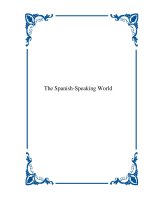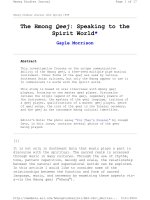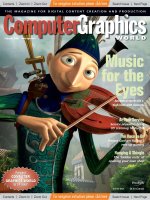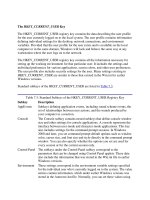Tài liệu The Spanish-Speaking World doc
Bạn đang xem bản rút gọn của tài liệu. Xem và tải ngay bản đầy đủ của tài liệu tại đây (291.9 KB, 35 trang )
The Spanish-Speaking World
Unit 1: Welcome to the Spanish-Speaking World
This unit emphasizes the alphabet, greetings, numbers 0-59, dates,
months, seasons, punctuation, and time.
Unit Focus
Communication
• Express likes and dislikes when asked simple questions
(e.g., about toys or other objects). (FL.A.1.1.1)
• Greet others and exchange essential personal information
(e.g., home address, telephone number, place of origin,
and general health). (FL.A.1.1.2)
• Use appropriate gestures and expressions (i.e., body
language) to complete or enhance verbal messages.
(FL.A.1.1.3)
• Express likes or dislikes regarding various objects,
categories, people, and events present in the everyday
environment. (FL.A.1.2.1)
• Use repetition, rephrasing, and gestures effectively to
assist in communicating spoken messages. (FL.A.1.3.4)
• Follow and give simple instructions (e.g., instructions to
participate in games or instructions provided by the
teacher for classroom tasks). (FL.A.2.1.1)
• Restate and rephrase simple information from materials
presented orally, visually, and graphically in class.
(FL.A.2.1.2)
• Listen and read in the target language
and respond through role playing,
drawing, or singing. (FL.A.2.1.4)
• Organize information in spoken or written form about a
variety of topics of academic and cultural interest (e.g., by
making lists, categorizing objects, or organizing
concepts). (FL.A.2.2.3)
• Comprehend and respond to oral messages (e.g.,
personal anecdotes or narratives) based on familiar
themes and vocabulary. (FL.A.2.2.5)
Culture
• Participate in age-appropriate cultural activities (e.g.,
games, songs, birthday celebrations, storytelling,
dramatizations, and role playing). (FL.B.1.1.1)
• Recognize various activities and celebrations in which
children participate in the target culture (e.g., games,
songs, birthday celebrations, storytelling, dramatizations,
and role playing). (FL.B.1.2.1)
Connections
• Use simple vocabulary and phrases to identify familiar
objects and concepts from other disciplines. (FL.C.1.1.1)
• Participate in activities in the language class designed to
integrate content-area concepts (e.g., mathematical
calculations or cause-and-effect relationships) into target-
language instruction (e.g., about countries or cultures).
(FL.C.1.2.1)
• Use target-language vocabulary or concepts to reinforce
knowledge of a related topic studied in another class
(e.g., geographical place names, parts of the body, or
basic mathematical operations). (FL.C.1.2.2)
• Use the target language to gain access to information that
is only available through the target language or within
the target culture (listen to a story told in the target
language). (FL.C.2.1.1)
Comparisons
• Use simple vocabulary and short phrases in the target
language. (FL.D.1.1.2)
• Recognize the similarities and differences between his or
her native language and the target language in terms of
the pronunciation, alphabet, and forms of written
expression. (FL.D.1.2.2)
• Distinguish the similarities and differences between the
patterns of behavior of the target culture related to
recreation, holidays, celebrations and the patterns of
behavior of the local culture. (FL.D.2.2.1)
• Recognize forms of the target language evident in the
local culture (e.g., signs, symbols, advertisements,
packages, displays, murals, songs, and rhymes).
(FL.D.2.2.2)
Experiences
• Know that many people in the United States use
languages other than English on a daily basis. (FL.E.1.2.1)
• Demonstrate an awareness of employment possibilities
(and other applications) for those who are able to master
the target language. (FL.E.1.2.2)
Unit 1: Welcome to the Spanish-Speaking World
5
Unit 1: Welcome to the Spanish-Speaking World
Overview
Spanish is spoken by over 340 million people in the world today. Spanish
is the second world language of international communication. The first
Spanish-speaking country was Spain. Spanish is also spoken in 19 Latin
American countries, in parts of Africa, and the Philippines. In the United
States, about one out of every 10 residents speaks Spanish.
In this unit you will learn the following:
• numbers 0-59 (los números)
• alphabet (el alfabeto, el abecedario)
• punctuation (la puntuación)
• greetings and goodbyes (los saludos y las despedidas)
• months of the year (los meses del año)
• days of the week (los días de la semana)
• dates (las fechas)
• seasons (las estaciones)
• time (la hora).
Unit 1: Welcome to the Spanish-Speaking World
7
Vocabulario (Vocabulary)
Use the vocabulary list below as a reference for this unit.
Los números (Numbers)
cero............................... 0
uno ............................... 1
dos ................................ 2
tres ............................... 3
cuatro ........................... 4
cinco............................. 5
seis ............................... 6
siete .............................. 7
ocho ............................. 8
nueve ........................... 9
diez ............................ 10
once ............................ 11
doce ............................ 12
trece ........................... 13
catorce ....................... 14
quince ........................ 15
dieciséis .................... 16
diecisiete ................... 17
dieciocho................... 18
diecinueve ................ 19
8
Unit 1: Welcome to the Spanish-Speaking World
veinte ......................... 20
veintiuno .................. 21
veintidós ................... 22
veintitrés ................... 23
veinticuatro .............. 24
veinticinco ................ 25
veintiséis................... 26
veintisiete ................. 27
veintiocho ................. 28
veintinueve .............. 29
treinta ........................ 30
treinta y uno ............. 31
treinta y dos ............. 32
treinta y tres ............. 33
treinta y cuatro......... 34
treinta y cinco .......... 35
treinta y seis ............. 36
treinta y siete ........... 37
treinta y ocho ........... 38
treinta y nueve ......... 39
Unit 1: Welcome to the Spanish-Speaking World
9
cuarenta..................... 40
cuarenta y uno ......... 41
cuarenta y dos .......... 42
cuarenta y tres .......... 43
cuarenta y cuatro ..... 44
cuarenta y cinco ....... 45
cuarenta y seis.......... 46
cuarenta y siete ........ 47
cuarenta y ocho ........ 48
cuarenta y nueve ..... 49
cincuenta................... 50
cincuenta y uno ....... 51
cincuenta y dos ........ 52
cincuenta y tres ........ 53
cincuenta y cuatro ... 54
cincuenta y cinco ..... 55
cincuenta y seis........ 56
cincuenta y siete ...... 57
cincuenta y ocho ...... 58
cincuenta y nueve ... 59
10
Unit 1: Welcome to the Spanish-Speaking World
El alfabeto or el abecedario (Alphabet)
The letters of the Spanish alphabet below are shown with the Spanish
pronunciation in parentheses ( ) and the English pronunciation in brackets [ ].
A .....................(a) ............... [ah]
B .................. (be) ............. [beh]
C ................... (ce) ..............[seh]
D .................. (de) ............. [deh]
E ......................(e) ............... [eh]
F .................. (efe) ........ [eh-feh]
G .................. (ge) ............. [heh]
H ............ (hache) ......[ah-cheh]
I....................... (i) ................[ee]
J.................. (jota) ........ [ho-tah]
K .................. (ka) ............. [kah]
L ...................(ele) ..........[el-leh]
M .............. (eme) ..... [em-meh]
N ................ (ene) ....... [en-neh]
Ñ ................ (eñe) ..... [ehn-yeh]
O .................... (o) ............... [oh]
P ................... (pe) ............. [peh]
Q .................. (cu) ............. [coo]
R ................. (ere) .............. [ere]
RR .............(erre) ......... [er-reh]
S .................. (ese) .........[es-seh]
T ................... (te) .............. [teh]
U .................... (u) ............... [oo]
V ...... (ve or uve) ............. [veh]
W ........(doble ve or doble uve)
...........................[doe-bleh veh]
X ............. (equis) ......... [eh-kis]
Y........................ (i griega or ye)
............................. [ee grie-gah]
Z ............... (zeta) .......[seh-tah]
The CH and LL have officially been dropped from the Spanish alphabet; however,
dictionaries and glossaries published before 1994 will continue to show them as
separate entries.
CH ............. (che) ........... [cheh] LL .............. (elle) ......... [ehyeh]
Unit 1: Welcome to the Spanish-Speaking World
11
Los saludos (Greetings)
Buenos días. ................................................................................ Good morning.
Buenas noches. ........................................................... Good evening (or night).
Buenas tardes. ........................................................................... Good afternoon.
¿Cómo estás? ................................................................................. How are you?
¡Hola! ................................................................................................. Hello! or Hi!
¿Qué pasa?.........................................What’s the matter? or What’s going on?
¿Qué tal? ..................................................................................... How’s it going?
12
Unit 1: Welcome to the Spanish-Speaking World
Responses to ¿Cómo estás? (How are you?)
Bien. ................................................................................................... Fine or Well.
Bien, gracias. ¿Y tú? ..................................................... Fine, thanks. And you?
Estoy bien. ........................................................................... I’m fine or I’m well.
Excelente. ................................................................................ Excellent or Great.
¡Horrible! ................................................................................................ Horrible!
Así, así. ..............................................................................................So-so or Fair.
(Muy) mal. ...........................................................................................(Very) bad.
Regular. ................................................................................. Regular or Normal.
Unit 1: Welcome to the Spanish-Speaking World
13
Las despedidas (Goodbyes)
Adiós. ..................................................................................................... Goodbye.
Bueno, tengo clase. ................................................................ Well, I have class.
Chao..................................................................................................................Bye.
Hasta luego. .................................................................................... See you later.
Hasta mañana. ...................................................................... See you tomorrow.
Tengo que irme. ............................................................................... I have to go.









